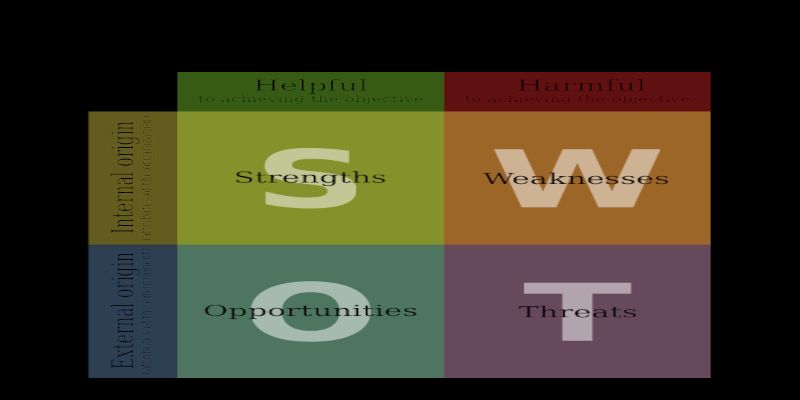Table of Contents
ToggleA great analyzing tool for strategic planning and strategic management is the SWOT analysis.
It can be used by businesses, companies, and even individuals to make a list of opportunities and threats, and a list of strengths and weaknesses which is then often clearly depicted in a SWOT matrix.
What is a SWOT analysis?

The acronym SWOT stands for:
- Strengths
- Weaknesses
- Opportunities
- Threats
SWOT analysis definition
A SWOT analysis, also commonly called a SWOT matrix, can be defined as a framework that’s commonly used to develop strategic planning and to evaluate a company’s competitive position in the market. Yet, it can also be used by a single individual to find out more about their specific strengths and weaknesses.
It analyzes both internal and external components while taking into account the current potential and the future potential. This means that it is not only a useful tool to use as a means to measure your current position but also to analyze the future.
The goal is to paint a realistic, data-driven, and fact-based picture instead of a subjective, prejudiced look at the current, as well as the future strengths and weaknesses of a company, organization, initiative, or person.
SWOT strengths

Strengths in SWOT analysis stand for the strong points of an organization. For example, a loyal customer base, great customer service, or being in possession of unique technology that no/few competitors have.
This means that strengths are internal components of the company, business, or individual that are considered beneficial.
A listing of all current strengths must be made to make a conscious, long-term plan to facilitate those particular strengths in the future. Be it to gain customers, make more money, or improve a certain service.
SWOT weaknesses

Weaknesses in SWOT analysis stand for the weak points of an organization. It is those weak spots that prevent an organization, company, or individual from working to its optimal capacity and strengths.
Weaknesses are the areas wherein we need to improve to stay competitive with our competitors.
This means that SWOT weaknesses are internal components of the company, business, or individual that are considered disadvantageous.
An example of potential weaknesses could be no loyal customer base, bad customer service, or not enough capital to invest in the company which can make it hard to grow or even to stay competitive.
SWOT opportunities

Opportunities in the SWOT stand for the well-disposed external factors that could give the organization an advantage or an edge compared to the competition.
This means that they are external components of the company, business, or individual that are considered favorable.
An example of external opportunities is if the manufacturing components that your company needs lower in price, then you can lower the price of your product as a whole, gaining an edge against the competition in your niche.
SWOT threats

Threats in the SWOT analysis refer to external components that can be a potential danger to the company as they can cause damage if left unchecked. Thus, we want to minimize the possibility of threats becoming a problem in the future.
This means that threats are external components of the company, business, or individual that are considered detrimental.
An example of an external threat is if the prices of the car components go up by the component manufacturers if someone is a car repair shop owner, then the price of their service will need to go up as well. This can potentially keep customers away from calling their services and, thus, making less money in the process.
SWOT chart

Strengths
- What are our advantages compared to the competition?
- To what resources do we have access?
- What positive qualities does our team possess? For example, knowledge, education, skills, reputation, and network.
- What merchandise is currently doing well?
- What services are currently performing well?
Weaknesses
- In what areas can we improve?
- Can we potentially get more resources?
- Are there things that your business needs to be competitive? (Investors, more resources, more customers…)
- What products are not performing well or underperforming?
- Is your team well-suited for the job?
- Is the placement of your company perfect for success?
Threats
- What are our disadvantages compared to the competition, what do our rivals do well?
- Is there any big competition that potentially wants to enter your market?
- What new rules threaten our business? Are our resources becoming more expensive and/or harder to get?
- What consumer trends threaten our business?
- Could future evolution in technology change how you conduct your business?
Opportunities
- What technology can we utilize to improve our operations?
- Can we expand our market and/or operations?
- Can we explore new market segments?
- Do customers think highly of you?
- Are there upcoming circumstances that your business may be able to benefit from to grow the company?
SWOT template

Benefits of a SWOT analysis
One of the largest benefits of a SWOT analysis is that the administration of an analysis costs no money, except the paper that’s used of course, but that’s negligible.
Another big advantage is that anyone who understands how a matrix and their business works can use it effectively to improve their productivity.
It also doesn’t take much time to effectively utilize it to address a challenging and complex situation. Expenses on expensive business advisers and external consultants can be saved, which is another added benefit.
The following list is the most important benefits of a SWOT:
- Get a better understanding of your business/company.
- Develop a vision for your company. Create purposeful business goals and strategies to achieve them.
- Take advantage of your strengths.
- Take advantage of presented opportunities.
- Understand and address weaknesses.
- Discourage threats.
Limitations of SWOT analysis

For starters, it is not suited for very large, complex issues since it is only a one-stage business planning process. For really complex cases, a more in-depth research process is generally needed to make balanced and well-thought-out decisions.
The biggest limitations of a SWOT analysis are:
- Only a one-stage business planning process.
- Does not necessarily prioritize issues like weaknesses and threats.
- Does not provide a solution to the problems. Serves as an analyzing tool.
- Produces a detailed and large amount of information, but some of the presented information might not be as relevant or useful.
- Can generate too many ideas, which can lead to not being able to see the forest for the trees.
How to create an effective SWOT analysis

Start with a specific objective.
The more specific you are, the easier and more effective the execution will be.
If you have multiple objectives, you may be better off doing multiple different SWOT matrices instead of just one.
Involve the whole team in the process.
People have different personalities and experiences. Thus, they will have different thoughts, opinions, and ideas.
Think of it as the more different points of view the better. Make sure to consider and respect each other’s point of view so everyone feels understood.
To include as many people as possible and to get more input, consider asking all the team members to fill in the SWOT matrix individually and come together afterward to fill out a SWOT matrix as a group.
What you may personally view as a strength may be considered a potential weakness by others. Likewise, what might look like an opportunity to you might look like a possible threat to others.
Make enough room for discussion.

While the matrix is quite simple, it can be quite challenging to discuss all the gathered ideas, results, and possible strategies for the future.
Always make enough room for discussion as even more possible strengths, weaknesses, opportunities, and threats may come forth out of it.
Rank the strengths, weaknesses, opportunities, and threats in order of importance.
After you’ve completed the matrix, you should rank the strengths, weaknesses, opportunities, and threats to make it as clear what the main takeaways and the most crucial points are.
Not all the presented information will be equally crucial. Thus, it can be helpful to order them in rank of importance.
It is critical to note that there might be:
- Matches between strengths and opportunities.
- Overlap where weaknesses correlate with threats.
- Possible ideas to change threats to opportunities and weaknesses into strengths in the future.
Final note

SWOT is an interesting framework that can be used to paint a realistic picture of someone’s or a company’s strengths, weaknesses, opportunities, and threats.
While it might not be the most adapted or suitable tool to solve very complex problems, it can be utilized to develop a strategic plan and strategic management for future success. Be it by a single individual, an organization, or a company.

